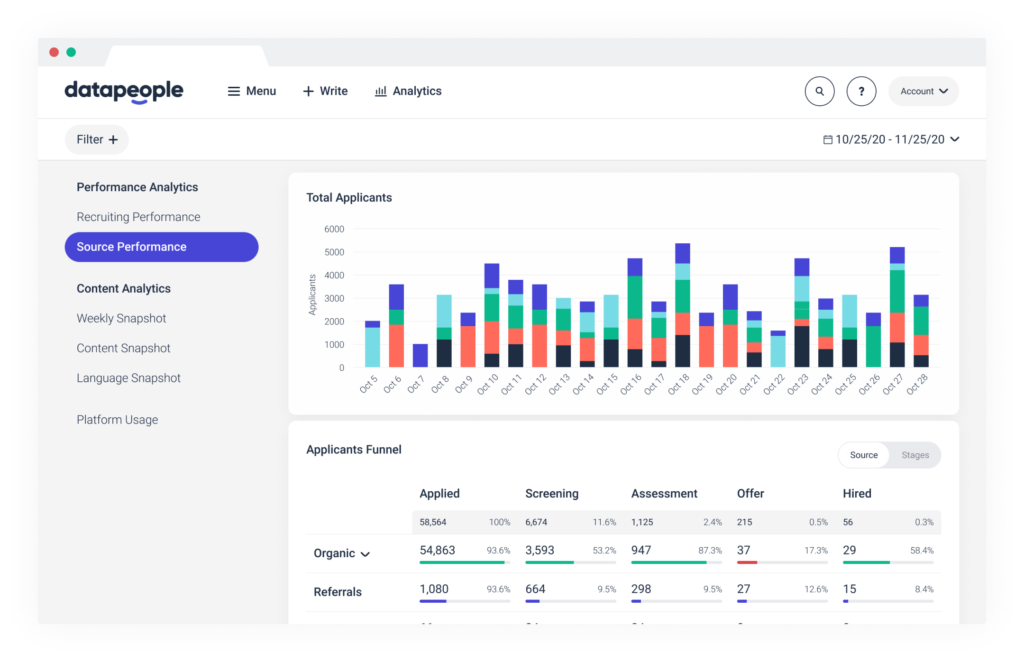Before Datapeople, there really wasn’t an easy way to track return on investment (ROI) for candidate sources. Yet there are real costs associated with sourcing. And you have to wonder: What is the cost of not knowing how your sourcing channels are performing?
Datapeople recruiting software solves the problem of determining how well your candidate sourcing strategy is working. Our Source Performance Report organizes your unwieldy applicant tracking system (ATS) data. So you understand how applicants enter your funnel and which sources produce qualified candidates and hires.
To determine ROI on candidate sources, you have to track where each candidate comes from and how far they get in your hiring process. To do that, you need a way to organize and augment the data in your applicant tracking system (ATS). Datapeople’s Recruiting Analytics Platform does the organizing and augmenting for you.
ATSs are a bit fussy
Your ATS can show you candidate sources and source performance, but you may struggle to get meaningful information out of it.
Part of the fussiness of these systems comes from how ATSs organize data. Your ATS may be set up to associate one job posting per requisition, for example. Changing a job title and starting a new requisition means having applicant data living on two requisitions. That makes it hard to quickly analyze or match up the data in reports. And you may see how long it took to fill a requisition, but you can’t see other influencing factors.
Also, the way hiring teams enter candidate information into the system can create data cleanliness issues. Users need to roll out candidate source tags in a consistent manner (especially if they’re manually tagging candidates) to organize all the candidates that come from a source into a single category.
Open text fields are a big problem. Your ATS can’t make leaps of logic and doesn’t always know that ‘ZipRecruiter,’ ‘Ziprecruiter,’ and ‘Zip Recruiter’ are the same thing. The source copy in open text fields has to be identical for reporting to accurately list all the candidates from that source.
ROI on candidate sources is difficult with an ATS alone
Even when your ATS uses an auto-tagging feature like a drop-down menu for candidate sources, things can still get messy. For example, an ATS may use multiple tags (e.g., ‘LinkedIn Job Slot’ or ‘LinkedIn Limited Listing’) to attribute candidates to LinkedIn. (In other words, it’s not just human error.)
ATSs are also infinitely configurable when it comes to recruiting funnels. Inside the same company, finance jobs may have three steps in the interview process while sales jobs may have five. An ATS reflects the unique pipeline stages of every single requisition, which is valuable for individual recruiters and hiring managers but detrimental for high-level reporting. Because it’s impossible to know how candidates are performing overall when each has a different interview experience.
While ATSs do a number of things really well, they don’t make it easy to aggregate candidate source or performance data and gauge ROI on your candidate sources. Not by themselves.
Datapeople makes gauging ROI on candidate sources easy
Again, what is the cost of not knowing how your sourcing channels are performing? If you’re flying blind, you could be wasting big chunks of your hiring budget and never know it. You could pay for a service like ZipRecruiter, of course. But there’s no way to tell if the candidates coming through are qualified or if the economics make sense. (In other words, qualified candidates come through, but the service is expensive).
Part of what our Recruiting Analytics Platform does is organize the data in your ATS. Datapeople understands, for example, that ‘LinkedIn’ and ‘LI’ are the same channel, even if your ATS doesn’t. That’s because our recruiting software uses natural language processing, language analytics, and bespoke rules to connect the dots.
Datapeople organizes and then augments your data, presenting it to you in meaningful ways. Our Source Performance Report is a perfect example of this. The report consolidates thousands of unique candidate source tags into specific channels, offering a clear view of your entire candidate sourcing pipeline. It also standardizes the applicant funnel into five consistent stages (Applied, Screening, Assessment, Offer, Hired) for an apples-to-apples comparison of how successfully candidates are advancing across all jobs.

Your hiring team can use the report to see exactly where your applicants are coming from. That includes organic, referral, social media, and other sourcing channels. They can also see how far applicants make it through your hiring process.
Hiring team members can use dropdown menus to dive more deeply into your different channels as well. For example, you can see what percentages of your hires are coming from a sourced channel. You can view separate metrics for sources like agencies, sourcing platforms, and prospecting. So you know where to dial down or dial up recruiting spend.
Stop flying blind
Datapeople’s Source Performance Report simplifies source reporting by making it very clear which inbound source your applicants and hires are coming from. With that information, you can determine which candidate sources are working for you and which aren’t. Then you can adjust your efforts and budget accordingly.
If you’d like to learn more about Datapeople, schedule a demo to connect with one of our talent attraction experts.
